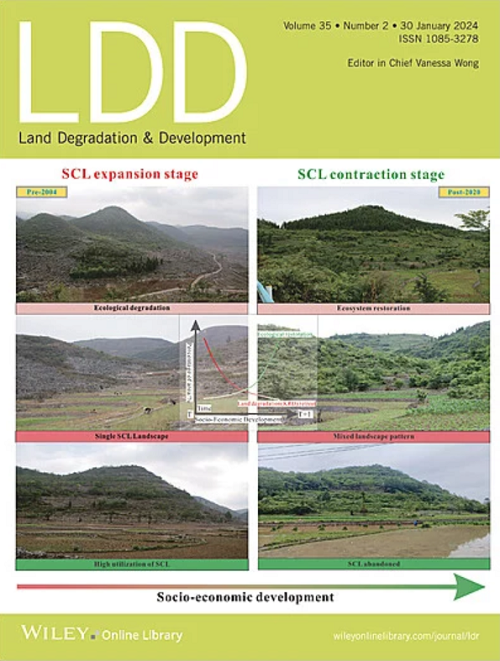Heavy Metal Contamination in Arenillas Ecological Reserve Soils: Correlation and Conservation Impact
IF 3.6
2区 农林科学
Q2 ENVIRONMENTAL SCIENCES
引用次数: 0
Abstract
This study addresses the critical knowledge gap regarding heavy metal contamination in the soils of the Arenillas Ecological Reserve (AERv), located on the southwest coast of Ecuador. Despite being a fragile and highly biodiverse ecosystem, little is known about the magnitude, spatial distribution, and drivers of heavy metal contamination in this reserve. Soil samples were collected at a depth of 0 to 10 cm from mangrove areas (MANg), salt marshes (SMe), and dry forests (Df) to assess concentrations of copper (Cu), manganese (Mn), iron (Fe), zinc (Zn), lead (Pb), and chromium (Cr) and their correlation with physicochemical properties. Analytical methods included one‐way ANOVA, Pearson correlation, cluster analysis (CA), and the application of the geo‐accumulation index (Arenillas生态保护区土壤重金属污染:相关性与保护影响
本研究解决了关于Arenillas生态保护区(AERv)土壤重金属污染的关键知识差距,位于厄瓜多尔西南海岸。尽管这是一个脆弱和高度生物多样性的生态系统,但对该保护区重金属污染的规模、空间分布和驱动因素知之甚少。在红树林区(MANg)、盐沼区(SMe)和干旱林区(Df)的0 ~ 10 cm深度采集土壤样品,评估铜(Cu)、锰(Mn)、铁(Fe)、锌(Zn)、铅(Pb)和铬(Cr)的浓度及其与理化性质的相关性。分析方法包括单因素方差分析、Pearson相关分析、聚类分析(CA),以及应用地理积累指数(Igeo)和污染负荷指数(PLI)来量化污染水平。结果显示,MANg、SMe和南部干旱森林(Df‐S5)的重金属浓度升高,超过了先前研究报告的阈值。值得注意的是,整个保护区的锌和铅污染水平从高到非常高,MANg土壤受所有金属的影响最大。金属的积累模式与土壤性质密切相关,如粉土和粘土含量、孔隙度、pH值和有机质,这些都会影响金属的保留和流动性。这种污染主要归因于人为活动,包括虾类养殖、传统农业以及来自采矿、家庭和附近城市地区工业排放的污染物。这些发现表明,迫切需要采取有针对性的恢复和保护措施,以保护保护区的生物多样性和生态系统服务。它们还强调必须更新法规和缓解战略,以有效管理污染,为厄瓜多尔AERv和其他保护区的可持续管理做法奠定基础。
本文章由计算机程序翻译,如有差异,请以英文原文为准。
求助全文
约1分钟内获得全文
求助全文
来源期刊

Land Degradation & Development
农林科学-环境科学
CiteScore
7.70
自引率
8.50%
发文量
379
审稿时长
5.5 months
期刊介绍:
Land Degradation & Development is an international journal which seeks to promote rational study of the recognition, monitoring, control and rehabilitation of degradation in terrestrial environments. The journal focuses on:
- what land degradation is;
- what causes land degradation;
- the impacts of land degradation
- the scale of land degradation;
- the history, current status or future trends of land degradation;
- avoidance, mitigation and control of land degradation;
- remedial actions to rehabilitate or restore degraded land;
- sustainable land management.
 求助内容:
求助内容: 应助结果提醒方式:
应助结果提醒方式:


